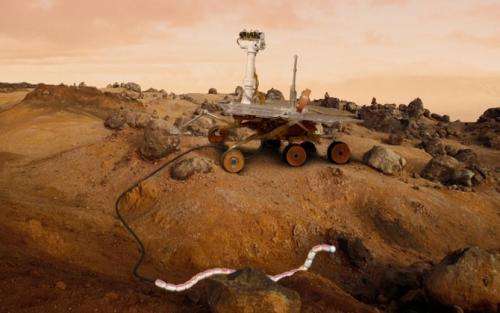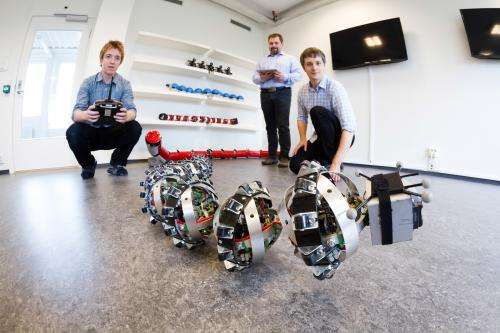Snake robot on Mars?

The ESA wants its operations on other planets to have greater mobility and manoeuvrability. SINTEF researchers are looking into whether snake robots could be the answer.
So far, NASA has landed four rovers on Mars. These are solar-powered robots with six wheels and robotic arms that can take soil samples and operate cameras. Sojourner landed in 1997, Spirit and Opportunity in 2003, while the more advanced Curiosity was landed last summer.
"Manoeuvrability is a challenge. The Spirit rover was lost after it became stuck in the sand on Mars. The vehicles just cannot get to many of the places from which samples have to be taken", say Pål Liljebäck and Aksel Transeth at SINTEF ICT.
The researchers are busy working on a feasibility study assigned to them by the ESA. The ESA and the researchers believe that by combining a rover that can navigate over large distances with a snake robot that can crawl along the ground and can get into inaccessible places, so many more possibilities could be opened up.
At the moment, soil samples from Mars are analysed on board the rover itself, and the results are communicated back to Earth. However, The ESA also wants to examine options that could allow samples to be returned to Earth. Snake robots could assist with collecting such samples, since they enable access to tight spots that the rovers cannot reach.
An arm becomes a snake robot
"We are looking at several alternatives to enable a rover and a robot to work together. Since the rover has a powerful energy source, it can provide the snake robot with power through a cable extending between the rover and the robot. If the robot had to use its own batteries, it would run out of power and we would lose it", explains Aksel Transeth.
"One option is to make the robot into one of the vehicle's arms, with the ability to disconnect and reconnect itself, so that it can be lowered to the ground, where it can crawl about independently".

The researchers envisage using the rover to navigate over large distances, after which the snake robot can detach itself and crawl into tight, inaccessible areas. A cable will connect the robot to the vehicle. The cable will supply power and tractive power, i.e. it can be winched back to the rover. Communication between the pair will be facilitated via signals transmitted down the cable.
"The connection between the robot and the rover also means that the snake robot will be able to assist the vehicle if the latter gets stuck", says Liljebäck. "In such a situation, the robot could lower itself to the ground and coil itself around a rock enabling the rover pull itself loose by means of the cable winch, which the rover would normally use to pull the snake robot towards the rover".
Report to the ESA
"At the Department of Applied Cybernetics, we have been working closely with the Norwegian University of Science and Technology's (NTNU's) Department of Engineering Cybernetics on snake robots for many years, and our teams have had some ideas about this for a long time", say Transeth and Liljebäck. "It is only now that we are starting to see some actual applications, and it is wonderful to be given this opportunity to provide the ESA with information about future technologies in this field. What we hope is that our ideas will trigger the ESA into initiating a targeted development process around this kind of system".
Provided by SINTEF





















